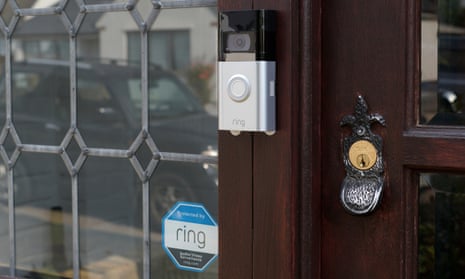The latest iteration of Amazon’s battery-powered Ring doorbell adds a new feature to capture the early details of events most competitors would miss without needing to be plugged in.
The Ring Video Doorbell 4 costs £179 ($199.99/$A329) and can be installed in any home with wifi. It tops Ring’s battery-powered range, which starts at £89.
The look and basic function of the Doorbell 4 is very similar to Ring’s older models. It has a camera with night vision, motion sensors and a large doorbell button.
When someone pushes the button Ring’s signature chime plays and an alert is sent to your phone. You can view a live feed and speak through the doorbell using the app from anywhere with internet. If you don’t answer, the new “quick replies” feature is like an answering machine for your door, recording caller’s messages. And it works as a motion-activated security camera too.
Four seconds of pre-roll

Most battery-powered doorbells sleep until motion is detected to save power, which means they typically only capture the second half of an event as it takes time for the camera to wake up and start recording.
Ring’s “pre-roll” system fills in the gap before the motion sensor is tripped. It takes a clip from a looping four-second lower-resolution colour recording that can be operated all the time without draining the battery too much.
It is a gamechanger for battery doorbells, giving you a much better idea of what has happened before the main camera fires up.
Video, motion and replay

The main 1080p HD video is clear and sharp enough to discern faces and name tags, and recorded HDR (high dynamic range) to better handle the sun shining straight at your door. The infrared night vision is bright and clear, too.
You can adjust the motion sensitivity and define areas you want monitored so that you only get notifications when something happens in the chosen zone, which is particularly useful for avoiding notification overload if your doorbell faces the street.
Ring Protect
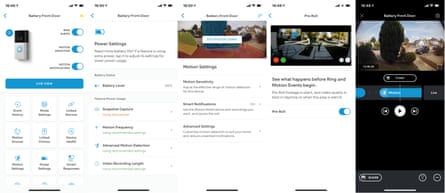
While standard motion and doorbell notifications, live view and pre-roll are free, you need to subscribe to Ring Protect to get the most out of the doorbell. A free 30-day trial is included so you can see what it does, and plans start at £2.50 a month, but it is essentially cloud recording for your videos as they are not stored locally.
You get up to 30-day event history, messages recorded by visitors from the quick replies feature and still snapshots taken every 14 minutes to fill in the gaps between events.
Ring Protect also enables smart motion alerts, to differentiate between people and other things such as cars, and rich notifications, which show an image of the motion or person within the alert on your phone.
Set up and battery life
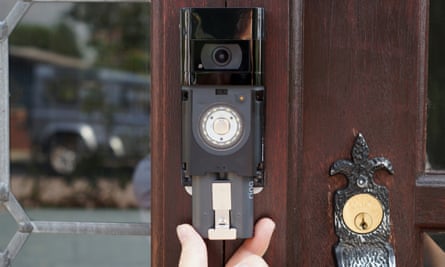
Setting up the doorbell is very easy. It comes with screws and wall plugs, plus a bracket for angling the camera towards your door if needed and cables for attaching it to an existing doorbell wire and chime if you have one.
The doorbell can be held in place by sticky strips if you can’t damage the mounting surface, such as if you’re renting. I used a set of Command-brand foam strips, but Ring sells a £17 “no-drill mount” that achieves something similar.
Once it is mounted you just slot the battery in the bottom, open up the Ring app on your smartphone and scan the QR code on the side of the bell. The app will run through the rest of the setup in about five minutes.

If you don’t have a traditional chime you can buy the wireless £29 Ring Chime or use any existing Amazon Alexa devices in your home to ring instead.
Battery life varies depending on how many features such as snapshot and pre-roll you have on and the number of motion events and live views. With everything active and capturing roughly 45 events a day, the battery lasts about a month. I would buy a second £20 battery as it takes at least five hours to fully charge the battery via microUSB.
Privacy
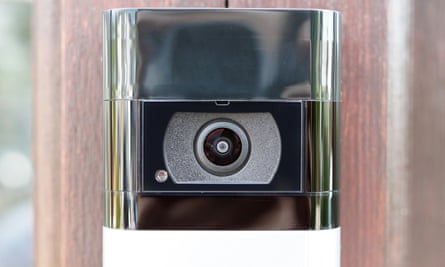
You can block the recording of certain parts of the camera’s view such as your neighbour’s drive using privacy zones. Ring has recently added options to limit how long recorded videos are stored on a camera-by-camera basis, strengthened account security with two-factor authentication and, in addition to standard encryption, has enabled the activation of end-to-end encryption (E2EE) for videos.
E2EE offers the strongest protection and means only the mobile devices you select can decrypt and watch captured videos. No one else can see the video, not even Ring. But with E2EE turned on some more advanced features such as pre-roll, snapshots, the event timeline, rich notifications and Alexa integration for watching a live feed from an Echo Show cannot be used.
Sustainability
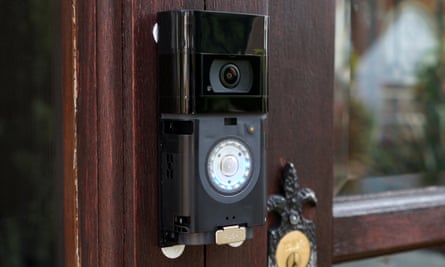
The Ring Video Doorbell 4 is generally repairable and a range of spare parts, including the rechargeable battery, are available at reasonable cost. Most parts are also interchangeable with older models. The company will support its devices with software updates for least four years from the point it stops selling the device on its site, and continues to support all of the devices it has sold so far.
Ring offers trade-in and recycling schemes through Amazon for its devices, but it did not comment on the use of recycled materials in the Doorbell 4. Ring falls under Amazon’s climate and sustainability pledges.
Observations

The response time to live view requests through the app is shorter than previous Ring models, but it can still take a few seconds to answer the door, so Ring has a separate stripped-down Rapid Ring app that is faster to load, which can be used for answering rings alongside the main Ring app.
Alexa smart displays can show a live feed on demand or automatically when the doorbell rings.
Price
The Ring Video Doorbell 4 costs £179 ($199.99/$A329) and Ring Protect costs from £2.50 a month.
For comparison, the Ring Video Doorbell (2nd gen) costs £89, the Ring Video Doorbell Pro 2 costs £219, the Google Nest Doorbell costs £179.99 and the Arlo Video Doorbell Wire-Free costs £179.
Verdict
The Ring Video Doorbell 4 is yet another great battery-powered smart doorbell from Amazon.
It intentionally doesn’t look any different from previous versions, so that parts are interchangeable and the older models don’t look dated. But it wakes up faster, the colour pre-roll captures much more of each event and its night vision is really good.
It can be installed almost anywhere but it needs good wifi so you might need a booster. You’ll probably need the extra £29 Chime too, which brings the real cost to £189 as a bundle, plus the £2.50 a month subscription to really make the most out of it as it doesn’t have local video storage.
Note the Ring Android app has an extremely annoying hard-coded pattern of four strong and long vibrations for every motion alert. It cannot be changed, which forced me to disable motion alerts entirely and lost the Doorbell 4 a star. Ring said it is working to fix the problem by the end of the year. This issue does not exist for the Ring iPhone app, however.
Pros: easy to install, clear video, great colour pre-roll, lots of accessories, solid iPhone app, faster, quick replies, snapshots, Alexa device integration, great as a regular doorbell replacement, end-to-end encryption available.
Cons: no local storage means you need Protect subscription for event review, no constant video recording, fairly wide for some door frames, battery needs charging once a month, Chime likely needed.
